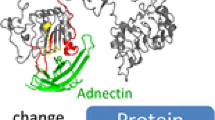Summary
Epidermal growth factor (EGF) was labelled with biotin via modification of either the amino or carboxyl groups, using suitable reagents, namely biotinyl-N-hydroxysuccinimide ester or biotinamidocaproyl hydrazide. To assure that the specific binding capacity of EGF is retained despite its chemical modification, displacement of the EGF by biotinylated derivatives in a routine binding assay was performed. The inhibitory potency compared to unmodified EGF was only slightly reduced. This result is the prerequisite for testing the usefulness of biotinylated EGF in histochemistry. The biotinylated probes were applied to sections of human tumour tissue and of monkey organs (liver, kidney, uterus of Cynomolgus and Rhesus monkey) to localize the specific binding sites for EGF. Formalin-fixed, paraffin-embedded tissue sections were deparaffinized and incubated with the probes at a concentration of 10 μg ml−1 at room temperature for 60 min. Specific binding of the EGF was visualized by the avidin-biotin techniques (ABC). A positive reaction in conjunction with appropriate controls by competitive inhibition was seen for all monkey tissue sections and for the following number of cancer cases: breast carcinoma: 7/10; mesothelioma: 2/4; lung carcinoma: 1/3; colon carcinoma: 1/3.
The staining properties were similar for both types of probes that differed in the functional group that is involved in modification by biotion attachment. However, the batches with modification of the amino groups stained more intensely and more distinctly than the carboxyl modified EGF. Overall, the data indicate that the ligand properties of the EGF are not impaired by biotinylation of the two types of functional groups. Thus, biotinylated EGF is a useful tool for histochemical detection and identification of EGF specific binding sites in mammalian tissue.
Similar content being viewed by others
References
Basu, A., Murthy, U., Rodeck, U., Herlyn, M., Mattes, L. &Das, M. (1987) Presence of tumour associated antigens in epidermal growth factor receptor from different human carcinomas.Cancer Res 47, 2531–6.
Carlin, C. R. &Knowles, B. (1986) Biosynthesis and glycosylation of the epidermal growth factor receptor in human tumour-derived cell lines A431 and Hep 3B.Mol. Cell. Biol. 6, 257–64.
Carpenter, G. (1987) Receptors for epidermal growth factor and other polypeptide mitogens.Ann. Rev. Biochem. 56, 881–914.
Carpenter, G. &Cohen, S. (1979) Epidermal growth factor.Ann. Rev. Biochem. 48, 193–216.
Damjanov, I., Mildner, B. &Knowles, B. (1986) Immunohistochemical localization of the epidermal growth factor in normal human tissue.Lab. Invest. 55, 588–92.
Gill, G. N., Bertics, P. J. &Santon, J. B. (1987) Epidermal growth factor and its receptor.Mol. Cel. Endo. 51, 169–86.
Fisher, P. B., Bozzone, H. J. &Weinstein, I. B. (1979) Tumour promotors and epidermal growth factor stimulate anchorage-independent growth of adenovirustransformed rat embryo cells.Cell 18, 695–705.
Foxwell, B., Taylor, T., Greiner, B., Mihatsch, M., Olivieri, V., &Ryffel, B. (1988) Biotinylated recombinant interleukin-2. A tool for research on the interleukin-2 receptor.J. Immunol. Meth. 113, 221–9.
Harrison, J. &Auersperg, N. (1983) Epidermal growth factor enhances viral transformation of granulosa cells.Science 222, 771–8.
Heinemann, V. &Jehn, U. (1985) Wachstumsfaktoren.Klin. Wochenschr. 63, 740–6.
Hendler, F. J. &Ozanne, B. W. (1984) Human squamous cell lung cancers express increased epidermal growth factor receptors.J. Clin. Invest. 74, 647–51.
Hopkins, D. R., Boothroyd, B. &Gregory, H. (1981) Early events following the binding of epidermal growth factor to surface receptors on ovarian granulosa cells.Eur. J. Cell Biol. 24, 259–65.
Hunter, W. H. &Greenwood, F. C. (1972) Preparation of iodine-131 labelled human growth hormone of high specific activity.Nature 194, 495–6.
Kayser, K., Gabius, H. J., Ciesiolka, T., Ebert, W. &Bach, S. (1989a) Histopathological evaluation of application of labelled neoglycoproteins in primary bronchus carcinoma.Hum. Pathol. 20, 352–60.
Kayser, K., Heil, M. &Gabius, H. J. (1989b) Is the profile of binding of a panel of neoglycoproteins useful as a diagnostic marker in human lung cancer?Path. Res. Pract. 184, 621–9.
Kohnke-Godt, B., &Gabius, H. J. (1989) Heparin-binding lectin from human placenta: purification and partial molecular characterization and its relationship to basic fibroblast growth factors.Biochem. 28, 6531–8.
Macias, A., Azavedo, E., Hägerström, T., Klintenberg, C., Perez, R. &Skoog, L. (1987) Prognostic significance of the receptor for epidermal growth factor in human mammary carcinoma.Anticancer Rev. 7, 459–64.
Newman, W., Beall, I. D., Levine, M. A., Cone, J. L., Randhawa, Z. I. &Bertolini, D. R. (1989) Biotinylated parathyroid hormone as a probe for the parathyreoid hormone receptor.J. Biol. Chem. 264, 16359–66.
Nicholson, S., Halchrow, P., Sainsbury, J. R. C., Angus, B., Chambers, P., Farndorn, J. R. &Harris, A. L. (1988) Epidermal growth factor receptor (EGFr) status associated with failure of primary endocrine therapy in elderly postmenopausal patients with breast cancer.Br. J. Cancer. 58, 810–14.
Rios, M. A., Macias, A., Perez, R., Lage, A. &Skoog, I. (1988) Receptors for epidermal growth factor and estrogen as predictors of relapse in patients with mammary carcinoma.Anticancer Res. 8, 173–6.
Roberts, M. L., Freston, J. A. &Reade, P. C. (1976) Suppression of immune responsiveness by a submandibular salivary gland factor.Immunol. 30, 811–14.
Rosenberg, M. B., Hawrot, E. &Breakefield, X. O. (1986) Receptor binding activities of biotinylated derivatives of β-nerve growth factor.J. Neurochem. 46, 641–8.
Stoscheck, C. M. &King, L. E. (1986) Role of epidermal growth factor in carcinogenesis.Cancer Res 46, 1030–7
Veale, D., Kerr, N., Gibson, G. J. &Harris, A. L. (1989) Characterization of epidermal growth factor receptor in primary human non-small cell lung cancer.Cancer Res. 49, 1313–17.
Waterfield, M. D., Mayes, E., Stroobant, P., Bennett, P., Young, S., Goodfellow, P., Banting, G. S. &Ozanne, B. (1982) A monoclonal antibody to the human epidermal growth factor receptor.J. Cell. Biochem. 20, 149–61.
Wojchowski, J. &Caslake, L. (1989) Biotinylated recombinant human erythropoietins: bioactivity and utility as receptor ligand.Blood 74, 952–8.
Yem, A. W., Zurcher-Neely, H. A., Richard, K. A., Staite, N., Heinrikson, R. &Deibel, M. (1989) Biotinylation of reactive amino groups in active recombinant human interleukin-1β.J. Biol. Chem. 264, 17691–7.
Author information
Authors and Affiliations
Rights and permissions
About this article
Cite this article
Kayser, K., Weisse, G., Gabius, H.J. et al. Biotinylated epidermal growth factor: a useful tool for the histochemical analysis of specific binding sites. Histochem J 22, 426–432 (1990). https://doi.org/10.1007/BF01003462
Received:
Revised:
Issue Date:
DOI: https://doi.org/10.1007/BF01003462




